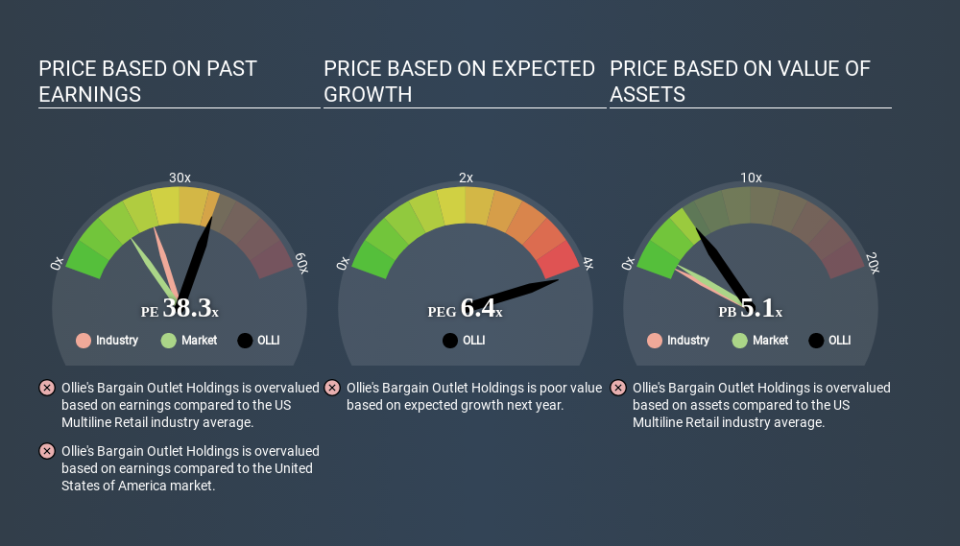A Rising Share Price Has Us Looking Closely At Ollie's Bargain Outlet Holdings, Inc.'s (NASDAQ:OLLI) P/E Ratio

Ollie's Bargain Outlet Holdings (NASDAQ:OLLI) shares have continued recent momentum with a 38% gain in the last month alone. But shareholders may not all be feeling jubilant, since the share price is still down 16% in the last year.
Assuming no other changes, a sharply higher share price makes a stock less attractive to potential buyers. In the long term, share prices tend to follow earnings per share, but in the short term prices bounce around in response to short term factors (which are not always obvious). So some would prefer to hold off buying when there is a lot of optimism towards a stock. One way to gauge market expectations of a stock is to look at its Price to Earnings Ratio (PE Ratio). Investors have optimistic expectations of companies with higher P/E ratios, compared to companies with lower P/E ratios.
Check out our latest analysis for Ollie's Bargain Outlet Holdings
Does Ollie's Bargain Outlet Holdings Have A Relatively High Or Low P/E For Its Industry?
Ollie's Bargain Outlet Holdings's P/E of 38.35 indicates some degree of optimism towards the stock. The image below shows that Ollie's Bargain Outlet Holdings has a higher P/E than the average (22.5) P/E for companies in the multiline retail industry.
That means that the market expects Ollie's Bargain Outlet Holdings will outperform other companies in its industry. The market is optimistic about the future, but that doesn't guarantee future growth. So further research is always essential. I often monitor director buying and selling.
How Growth Rates Impact P/E Ratios
P/E ratios primarily reflect market expectations around earnings growth rates. When earnings grow, the 'E' increases, over time. That means unless the share price increases, the P/E will reduce in a few years. Then, a lower P/E should attract more buyers, pushing the share price up.
Ollie's Bargain Outlet Holdings increased earnings per share by 3.3% last year. And earnings per share have improved by 32% annually, over the last five years.
A Limitation: P/E Ratios Ignore Debt and Cash In The Bank
One drawback of using a P/E ratio is that it considers market capitalization, but not the balance sheet. So it won't reflect the advantage of cash, or disadvantage of debt. Hypothetically, a company could reduce its future P/E ratio by spending its cash (or taking on debt) to achieve higher earnings.
Such expenditure might be good or bad, in the long term, but the point here is that the balance sheet is not reflected by this ratio.
Is Debt Impacting Ollie's Bargain Outlet Holdings's P/E?
Ollie's Bargain Outlet Holdings has net cash of US$90m. That should lead to a higher P/E than if it did have debt, because its strong balance sheets gives it more options.
The Verdict On Ollie's Bargain Outlet Holdings's P/E Ratio
Ollie's Bargain Outlet Holdings trades on a P/E ratio of 38.3, which is above its market average of 15.1. EPS was up modestly better over the last twelve months. And the healthy balance sheet means the company can sustain growth while the P/E suggests shareholders think it will. What we know for sure is that investors have become much more excited about Ollie's Bargain Outlet Holdings recently, since they have pushed its P/E ratio from 27.8 to 38.3 over the last month. If you like to buy stocks that have recently impressed the market, then this one might be a candidate; but if you prefer to invest when there is 'blood in the streets', then you may feel the opportunity has passed.
Investors should be looking to buy stocks that the market is wrong about. People often underestimate remarkable growth -- so investors can make money when fast growth is not fully appreciated. So this free report on the analyst consensus forecasts could help you make a master move on this stock.
You might be able to find a better buy than Ollie's Bargain Outlet Holdings. If you want a selection of possible winners, check out this free list of interesting companies that trade on a P/E below 20 (but have proven they can grow earnings).
Love or hate this article? Concerned about the content? Get in touch with us directly. Alternatively, email editorial-team@simplywallst.com.
This article by Simply Wall St is general in nature. It does not constitute a recommendation to buy or sell any stock, and does not take account of your objectives, or your financial situation. We aim to bring you long-term focused analysis driven by fundamental data. Note that our analysis may not factor in the latest price-sensitive company announcements or qualitative material. Simply Wall St has no position in any stocks mentioned. Thank you for reading.


